Study the subtle differences between Africanized and common honey bees and why it's vital to your safety in our comprehensive guide.

How to Tell if Bees Are Africanized?
While you may think that distinguishing between Africanized bees and common honey bees is a task best left to experts, it's actually more feasible than you might imagine. You don't need a biology degree, nor do you have to be a beekeeper to notice the subtle differences.
Surprisingly, the differences extend beyond physical appearance, and understanding these can prove quite beneficial, especially if you find yourself in an area known for these more aggressive bees.
So, how can you discern these differences and why should you bother learning about them? Let's explore this intriguing topic further.
Key Takeaways
- Africanized bees are a hybrid species resulting from a cross between the African honey bee and various European honey bees.
- Africanized bees are smaller in size compared to regular honey bees, but their defensive nature compensates for their size.
- To accurately identify Africanized bees, a microscope and a good understanding of bee anatomy are required, as they have a different wing venation pattern and other physical differences.
- Africanized bees exhibit a higher level of aggression compared to European bees, are less selective about their nesting sites, and reproduce more quickly.
Understanding Africanized Bees
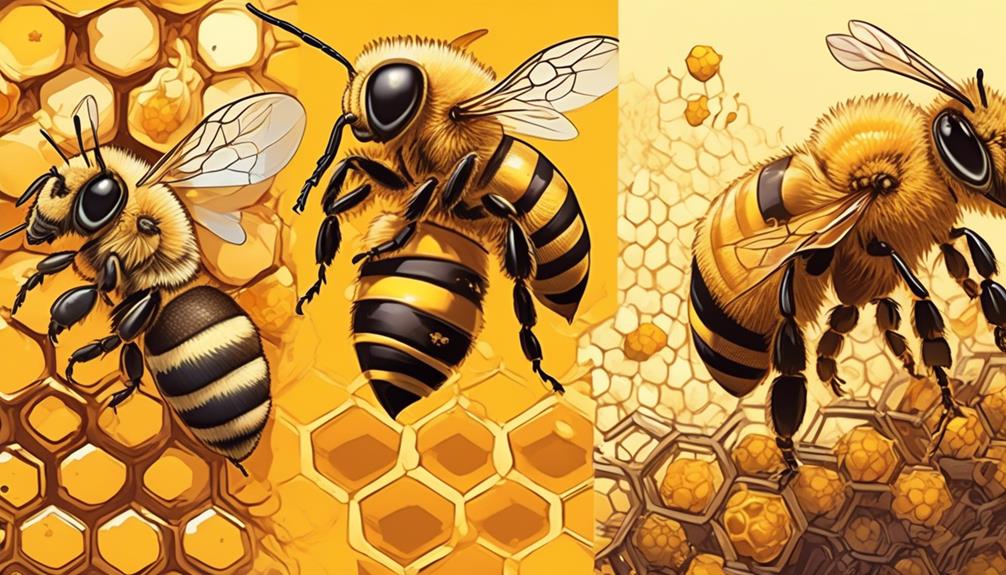
Diving into the world of Africanized bees, you'll find that they're a hybrid species resulting from a cross between the African honey bee and various European honey bees. Popularly known as 'killer bees,' they've gained a reputation for their aggressive behavior. Keep in mind, not every bee you encounter is an Africanized one. They're predominantly found in warmer climates, like South America and the Southern United States.
Now, you're probably wondering, how can you identify these bees? Well, it's quite challenging. They're almost identical in appearance to regular honey bees. However, their size is slightly smaller. But don't be deceived by their size. What they lack in stature, they make up for in their defensive nature. They're known to defend their colony more fervently and chase threats over long distances.
Research has shown that the aggression of Africanized bees can be linked to their genetics. They've inherited the defensive traits of their African ancestors, coupled with the hardiness of European honey bees. So, don't underestimate these small creatures – they've got quite a punch packed in their tiny bodies.
Identifying Physical Differences
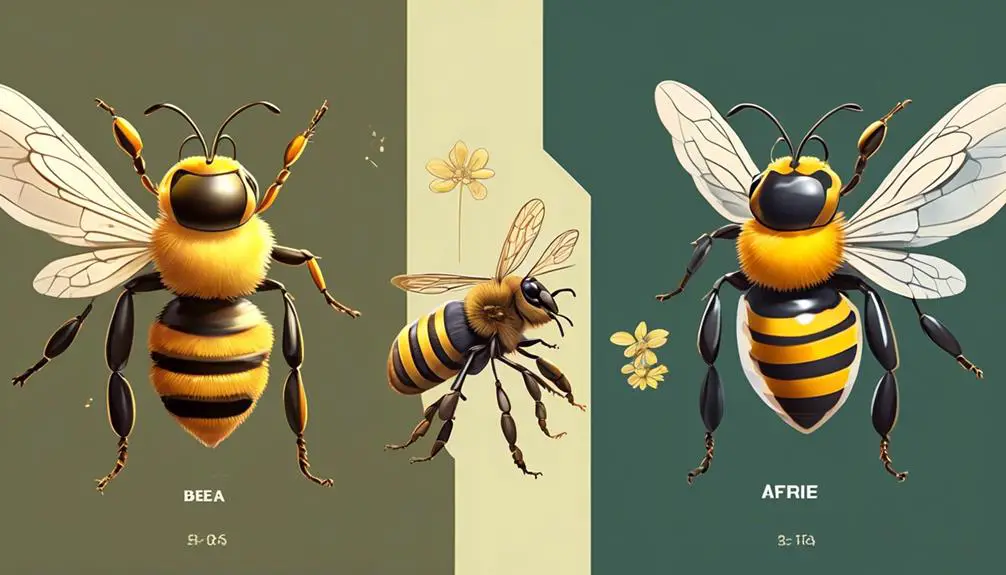
Spotting the physical differences between Africanized bees and other honey bees might seem like finding a needle in a haystack, but with a keen eye and a bit of knowledge, you can discern the subtle distinctions.
Africanized bees, often referred to as 'killer bees', are a hybrid species resulting from the crossbreeding of South African bees and European honey bees. They're very similar in appearance to regular honey bees which makes them hard to distinguish. However, they're marginally smaller, but this size difference is rarely noticeable to the naked eye.
To identify them accurately, you'd need a microscope and a good understanding of bee anatomy. The wing venation pattern of Africanized bees is different. Specifically, the second submarginal cell is smaller than the third, unlike in European honey bees.
Furthermore, the abdomen of an Africanized bee is more pointed, and they've fewer dorsal hooks on the hind wing. Also, their antennal scape (the first segment of the antenna) is longer than that of typical honey bees.
Noticing Behavioural Variances
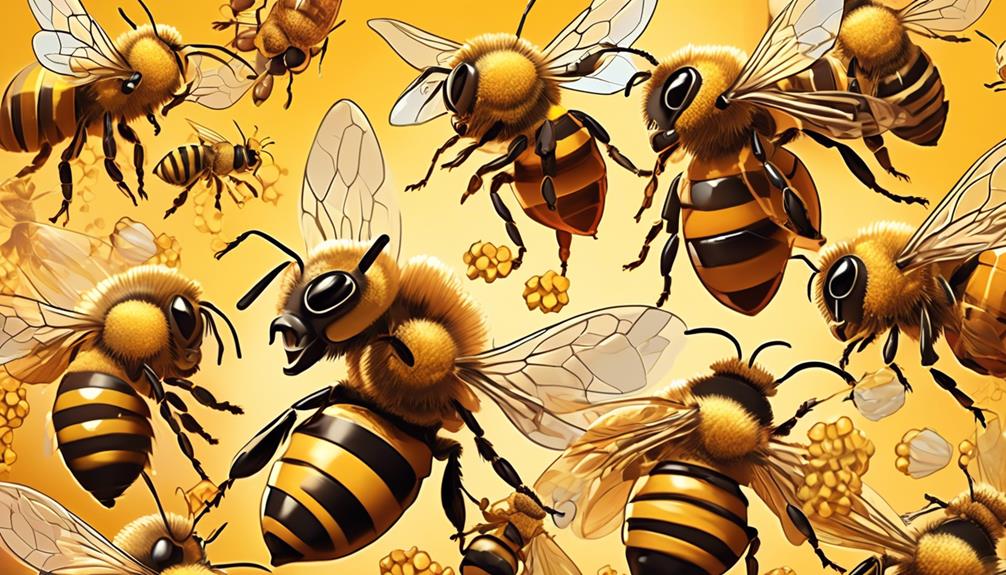
While physical characteristics may be subtle, it's the behavioral differences that often set Africanized bees apart from their European counterparts. Africanized bees, often referred to as 'killer bees', exhibit a higher level of aggression than European bees. They're not only quicker to defend their hive, but they'll also chase a perceived threat much further – up to a quarter of a mile.
You'll also notice that Africanized bees are more likely to sting in groups. A single bee attack can quickly escalate into a swarm. This is due to their heightened defensive behavior, which is a survival strategy in their native African environments.
Another distinguishing factor is their nesting behavior. Africanized bees aren't as selective about their nesting sites as European bees, and they often choose small, unusual places like empty containers or underground cavities. They're also more likely to abscond, or abandon their hive altogether, in response to environmental stressors.
Lastly, Africanized bees reproduce more quickly than their European counterparts. A queen can lay up to 1,500 eggs per day, which means their colonies can grow rapidly. This, combined with their aggressive behavior, makes them a significant threat if they establish a hive near human habitation.
Africanized Bees Habitat
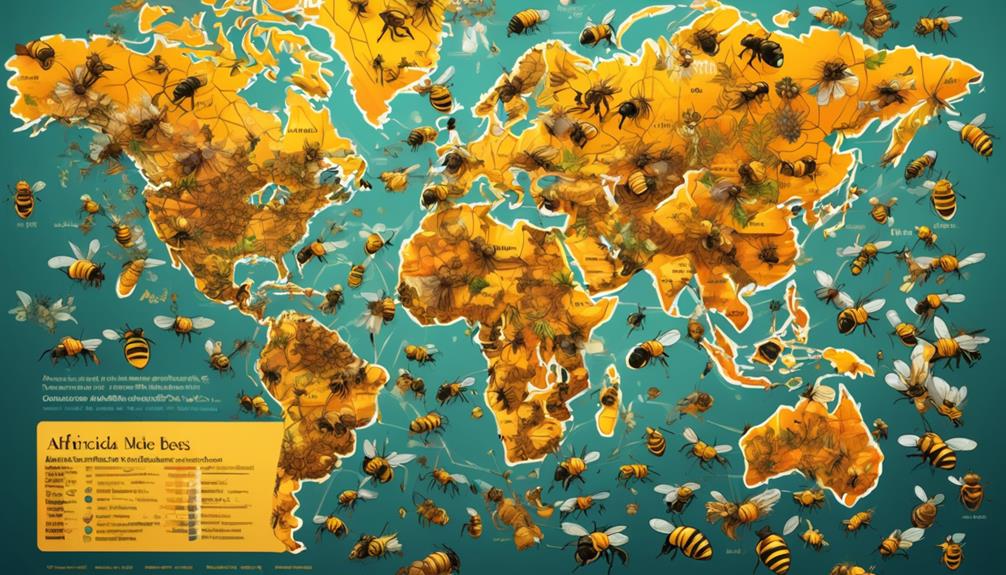
Moving on from their distinct behavior, it's crucial to understand the preferred habitats of Africanized bees to better identify and avoid potential encounters with these aggressive insects. These bees can thrive in a wide range of climates, but are particularly suited to tropical and subtropical regions. They're found extensively in Central and South America, and have made their way north into southern U.S. states.
The following table illustrates the Africanized bees' preferred habitats:
Habitat | Why It's Preferred | Potential Risk Level |
|---|---|---|
Tropical and subtropical regions | Warm, consistent temperatures | High |
Urban and suburban areas | Plenty of food sources, potential nesting sites | Moderate to High |
Agricultural areas | Abundant flowers for nectar and pollen | Moderate |
Forested areas | Numerous potential nesting sites | Low to Moderate |
Desert areas | Surprisingly, they can adapt well to arid conditions | Low |
It's evident that Africanized bees can adapt to a variety of habitats. Their aggressive nature and adaptability make them a potential threat in various environments. Knowledge of their preferred habitats can help you anticipate and avoid possible encounters. Remember, safety first when dealing with these bees.
Safety Measures Around Bees
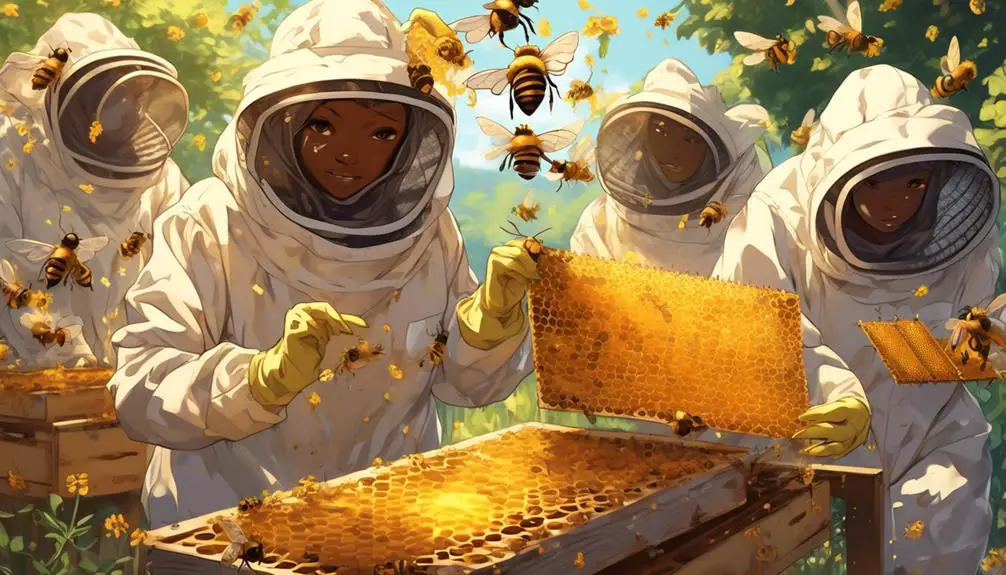
Understanding the right safety measures can make all the difference when you're in areas frequented by bees, particularly the aggressive Africanized variety. Firstly, it's crucial to wear protective clothing if you're venturing into their territories. A bee suit, gloves, and a veil can prevent stings to the face and body.
Avoid wearing dark, bright, or floral clothes as bees are attracted to these colors. Instead, opt for light-colored and smooth-textured clothing. Don't wear perfume or scented lotions as bees can mistake these for flower nectar.
If you encounter a swarm of bees, don't swat at them or make rapid movements. Instead, calmly and swiftly leave the area. If a bee stings you, don't pull out the stinger with tweezers or your fingers as this could release more venom. Instead, scrape it out sideways with a hard-edged object.
Lastly, if you're allergic to bee stings, carry an epinephrine auto-injector (EpiPen) with you at all times. In case of a severe allergic reaction, seek immediate medical help. Remember, knowledge is your best defense when dealing with Africanized bees.
Responding to Africanized Bee Stings

In the unfortunate event of getting stung by an Africanized bee, it's crucial that you know exactly how to respond to minimize pain and potential allergic reactions. First, remove the stinger as soon as possible. Africanized bee stingers are barbed and continue to pump venom into your skin even after detachment. Use a flat object like a credit card to scrape it off.
You'll then need to wash the area with soap and water to avoid infection. Apply a cold pack to reduce swelling, and consider taking an antihistamine to combat allergic reactions.
Here's a brief rundown of your response:
Action | Purpose |
|---|---|
Remove stinger | Stops the venom |
Cleanse the area | Prevents infection |
Apply cold pack | Reduces swelling |
If you experience symptoms like difficulty breathing, hives, nausea, or dizziness, seek medical attention immediately as these may indicate anaphylaxis, a severe allergic reaction. Always remember, your safety is paramount. An Africanized bee sting, while painful, is not typically life-threatening if handled correctly.
Frequently Asked Questions
What Are the Potential Health Risks Associated With Africanized Bee Stings?
Africanized bee stings can potentially pose serious health risks to you. While a single sting isn't usually harmful, these bees attack in swarms, leading to multiple stings. This could result in severe allergic reactions, difficulty breathing, swelling, and in rare cases, anaphylaxis.
You're also at risk for skin infections from sting sites. If you've been stung numerous times, it's crucial to seek medical attention immediately.
How Can One Differentiate Between an Africanized Bee and Other Types of Bees Based on Their Honey Production?
You can't really tell if bees are Africanized based on their honey production. Both Africanized and European bees produce similar amounts of honey. It's their behavior that's noticeably different.
Africanized bees are more aggressive and tend to defend their colonies more vigorously. If you're unsure, it's best to contact a professional beekeeper or local agricultural extension office for help in identifying the bees.
What Measures Can Farmers Take to Protect Their Livestock From Africanized Bees?
To protect your livestock from potential bee threats, you'll need to implement bee management strategies.
Regularly monitor your farm for bee nests and remove them safely. Use smoke or professional pest control if needed.
Ensure water sources are covered to discourage bees. Also, maintain a calm environment as loud noises can provoke bees.
How Have Africanized Bees Impacted Ecosystem Balance in Areas Where They Are Not Native?
Africanized bees have significantly impacted ecosystems where they're not native. They're more aggressive, outcompeting local bees for resources. This affects pollination, as fewer local bees means less variety in pollinated plants.
They also disrupt food chains, as they're predators to insects and small animals. You're seeing changes in plant diversity and animal populations in such areas.
To sum it up, they're causing ecological imbalance in these non-native regions.
Are There Any Benefits to the Presence of Africanized Bees in an Area?
Yes, there are benefits to having Africanized bees in an area. They're extremely resilient to diseases that often wipe out other bee populations.
They're also prolific pollinators, which can boost plant growth and diversity.
However, it's important to remember they're more aggressive than other bees. Always approach with caution, particularly if you're allergic to bee stings.
Conclusion
So, you've learned to distinguish Africanized bees from their less aggressive cousins. You've noted their physical differences, behaviour, and preferred habitats.
Always remember safety measures when near bees, and know how to react to a sting. Being aware of these factors can help ensure your safety and the bees' existence.
After all, understanding is the key to coexisting with these misunderstood, yet vital creatures.
Stay informed, stay safe, and appreciate the bees!


